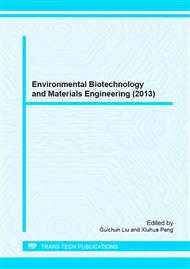[1]
J. M. Alvarez, S. Mace, P Llabres, Anaerobic digestion of organic solid wastes, An overview of research achievements and perspectives, Bioresource Technology. 74(2000) 3-16.
DOI: 10.1016/s0960-8524(00)00023-7
Google Scholar
[2]
P. Sosnowski, A. K. Smolka, K. Kaczorek, Kinetic investigations of methane co-fermentation of sewage sludge and organic fraction of municipal solid wastes, Bioresource technology. 99(2008)731-5737.
DOI: 10.1016/j.biortech.2007.10.019
Google Scholar
[3]
A.F. Gaudy, Colorimetric determination of protein and carbohydrate, Ind Water Wastes. (1962) 17-22.
Google Scholar
[4]
O.H. Lowery, N.J. Rosebrough, A.L. Farr, Protein measurement with the Folin phenol reagent. Biol. Chem. 193(1951) 265-275.
DOI: 10.1016/s0021-9258(19)52451-6
Google Scholar
[5]
Standard Methods for the Examination of Water and Wastewater, 21st ed., APHA, Washington DC. (2005).
Google Scholar
[6]
Y. F. Zhao, X. L. Liu, S. Z. Li, Characteristics of high-solids anaerobic co-fermentation for converting food waste and excess sludge to biogas, Transactions of the CSAE. 27(2011)255-260.
Google Scholar
[7]
S. T. Fu, S. L. Yu, X. J. Yan, Co-digestion of waste activated sludge and kitchen garbage, Environmental Science. 27(206)1459-1463.
Google Scholar
[8]
R. L. Gao, Q. Yan, W. Q. Ruan. Enhancement of biogas production from waste activated sludge by adding of kitchen wastes via anaerobic digestion, Chinese Journal of Bioprocess Engineering. 6(2008)31-35.
Google Scholar
[9]
Z. Beno, J. Boran, L. Houdkova, Co-fermentation of kitchen waste with sewage sludge, Rome:Chemical Engineering Transactions. (2009)677-682.
Google Scholar
[10]
Y. L. Zhu, W. Y. Zhang, F. Wang, Research on the anaerobic co-digestion of biodegradable municipal solid waste and waste sludge, Industrial Safety and Environmental Protection. 34(2008)9-11.
Google Scholar


